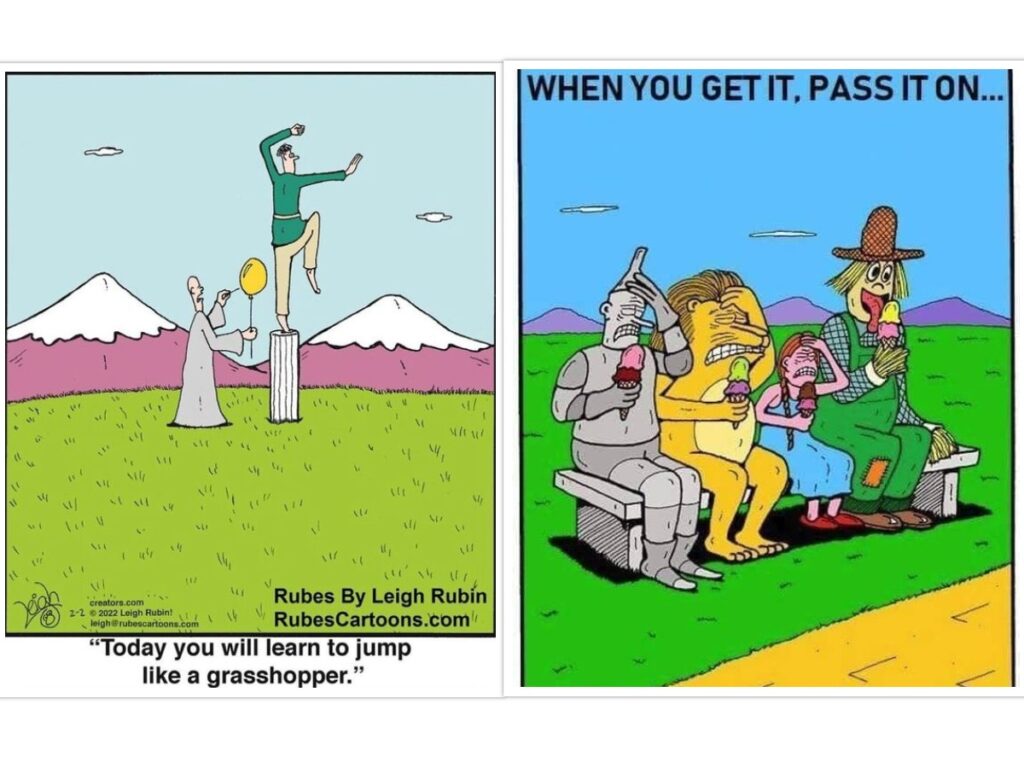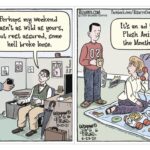Introduction to Rubes Cartoons
Rubes cartoons are a delightful and unique creation in the world of comic art, brought to life by the talented artist Leigh Rubin. Since its inception in 1984, Rubes has offered a daily dose of humor through newspapers and digital platforms worldwide. Known for its witty and often absurd humor, Rubes cartoons have carved out a special place in the hearts of its followers. The single-panel format of these cartoons encapsulates a universe of humor, ranging from the everyday mundane to the wildly imaginative scenarios, all depicted with Rubin’s distinctive artistic style.
Artistic Style and Themes: Rubes Cartoon
Leigh Rubin’s artistic style in Rubes cartoons is immediately recognizable and is an essential component of the cartoon’s charm. The artwork is characterized by its attention to detail, expressive characters, and a certain whimsical quality that complements the humor perfectly. Themes in Rubes cartoons are remarkably varied, covering everything from domestic life and workplace scenarios to outlandish and fantastical situations. Rubin has a knack for finding humor in the ordinary and presenting it in unexpected and often surreal contexts.
Audience Engagement and Reception: Rubes Cartoon
Over the years, Rubes cartoons have garnered a large and dedicated following. Fans appreciate the smart humor, the surprise element, and the way Rubin plays with language and visual puns. The universal appeal of Rubes lies in its ability to connect with a diverse audience. Whether it’s a laugh-out-loud moment or a subtle chuckle, Rubes cartoons have a way of making their way into the hearts of readers, prompting them to share the joy with others.
Impact and Legacy: Rubes Cartoon
The impact of Rubes cartoons extends beyond the daily chuckle. Leigh Rubin, through his work, has contributed significantly to the genre of single-panel cartoons. He has inspired budding cartoonists and has been a staple in the industry for decades. His work is not just about humor; it’s a commentary on life, relationships, and the absurdity of the human condition. Rubes cartoons have become a part of popular culture, often referenced and used in various educational and professional settings for their inherent wit and wisdom.
Credit: Rubes Cartoons
1
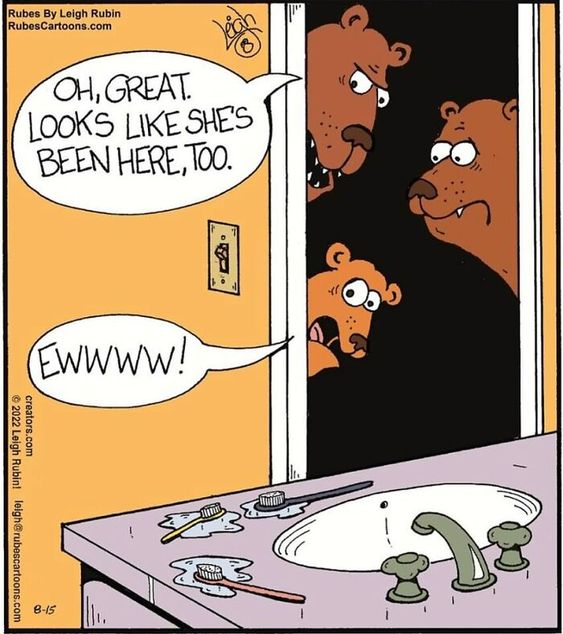
This image is a Rubes cartoon by Leigh Rubin, which shows a humorous scene involving three bears in a bathroom. The cartoon features a sink with green gunk around the faucets and discarded toothbrushes, suggesting a messy and unkempt area. One of the bears is peeking into the bathroom and sarcastically says, “Oh, great. Looks like she’s been here, too.” Another bear inside the bathroom, likely the child, is grossed out and exclaims, “EWWWW!” The joke here plays on the idea that someone, possibly a female family member, has left the bathroom in a messy state, which is relatable to many as a common household gripe. The bears’ human-like reactions and the messy bathroom provide a slice of everyday life with a twist, as it’s unexpected to see bears in such a human setting, which is a hallmark of the witty and playful humor found in Rubes cartoons.
2
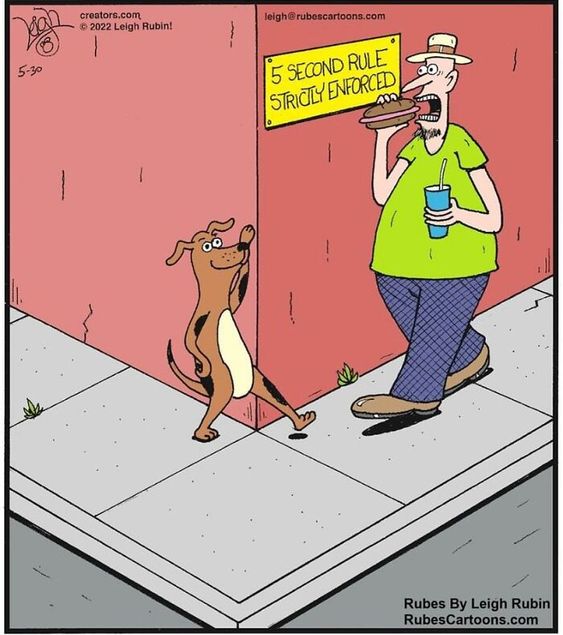
This Rubes cartoon by Leigh Rubin depicts a humorous situation on a sidewalk where a man is eating a sandwich and holding a drink, while a dog stands on its hind legs, eagerly looking at him. On the wall behind them is a sign that reads “5 SECOND RULE STRICTLY ENFORCED.” The 5-second rule is a common humorous saying that implies if food drops on the floor and is picked up within five seconds, it is still okay to eat. In this cartoon, the joke is that the rule is being “strictly enforced” in a public area, which is amusing because this ‘rule’ is typically something people might jokingly follow in their own homes. The eager dog seems to be waiting for the man to drop his food, hoping to take advantage of the 5-second rule himself. The humor in this Rubes cartoon plays on the interaction between the man’s casual eating, the presence of the watchful dog, and the absurdity of having such a rule posted in a public place.
3
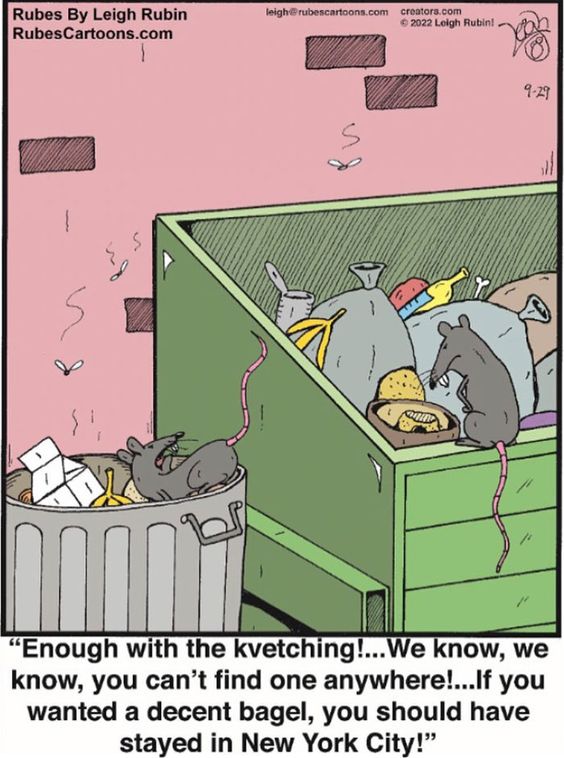
In this Rubes cartoon by Leigh Rubin, we see a group of rats rummaging through a dumpster full of trash. One rat is holding a bagel and another rat, seemingly tired of hearing complaints, says, “Enough with the kvetching!…We know, we know, you can’t find one anywhere!…If you wanted a decent bagel, you should have stayed in New York City!” The humor comes from the use of a well-known stereotype that the best bagels are found in New York City. The rats, typically seen as scavengers, are portrayed with human-like behavior and expectations, wanting not just any food, but a high-quality bagel, which adds a layer of wit to the scene. This is a common theme in Rubes cartoons, where animals are often shown in human-like scenarios, leading to a humorous twist on everyday situations.
4
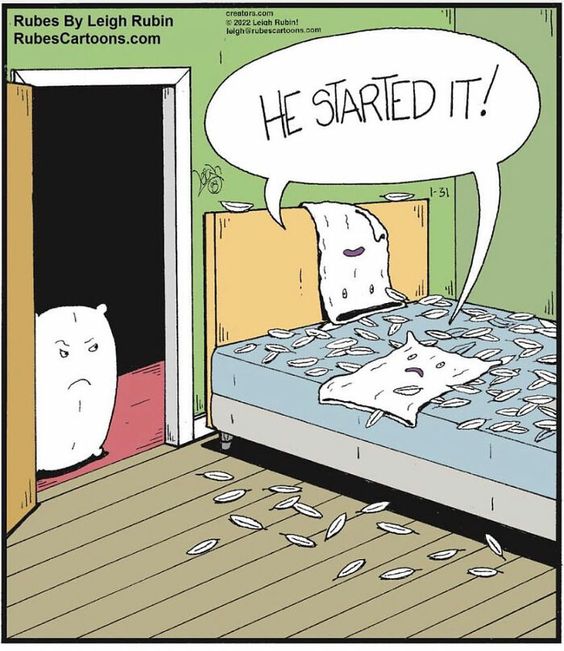
This Rubes cartoon presents a humorous situation where a pillow on a bed covered with feathers is exclaiming “HE STARTED IT!” as if in the middle of a fight. Another pillow, looking angry and deflated, is standing at the bedroom door, implying that it has been blamed for a pillow fight. The joke plays on the idea of siblings or children arguing over who started a fight, with the twist being that it’s inanimate objects, the pillows, that are depicted as having the argument. The feathers scattered all over the room suggest a pillow fight has indeed taken place, and the cartoon is anthropomorphizing the pillows, giving them human characteristics and behaviors, which is a common and amusing element in Rubes cartoons.
5
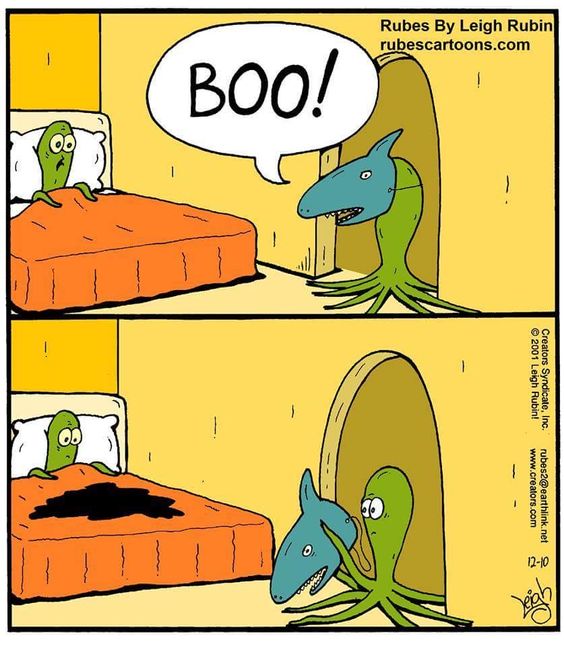
This Rubes cartoon illustrates a playful and ironic situation in two panels. In the first panel, a shark-like creature jumps out and yells “BOO!” to scare an octopus that is resting in bed. In the second panel, the scene continues to show the startled octopus has inked itself, which is a common defense mechanism for real octopuses when frightened. The humor in this cartoon lies in the reversal of roles where a sea creature typically known for its fearsome reputation is trying to scare another, which then reacts in an exaggerated and humorous way by releasing a large cloud of ink. The cartoon uses the element of surprise and the natural behavior of an octopus to create a funny and unexpected outcome, which is a hallmark of the clever and whimsical style of Rubes cartoons.
6
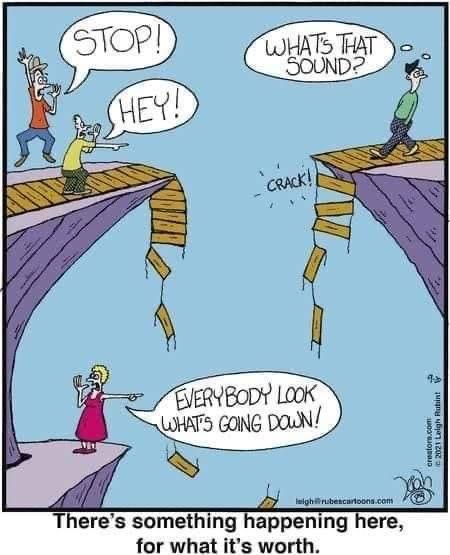
This Rubes cartoon by Leigh Rubin presents a humorous play on words set in a visual pun. We see a bridge with four people on it, which is broken in the middle. The first person shouts “STOP!” and the second asks “WHAT’S THAT SOUND?”, both warning of the imminent danger. The crack in the bridge suggests it’s about to collapse. Below, a woman points up at the scene saying, “EVERYBODY LOOK WHAT’S GOING DOWN!” which is a funny double meaning—it refers both to the literal event of the bridge (and potentially the people on it) going down due to the collapse, and the phrase is often used figuratively to draw attention to something happening. The cartoonist cleverly uses the lyrics from the song “For What It’s Worth” by Buffalo Springfield, which features the lines “Stop, hey, what’s that sound? Everybody look what’s going down,” giving a literal interpretation to this phrase in a comical setting.
7
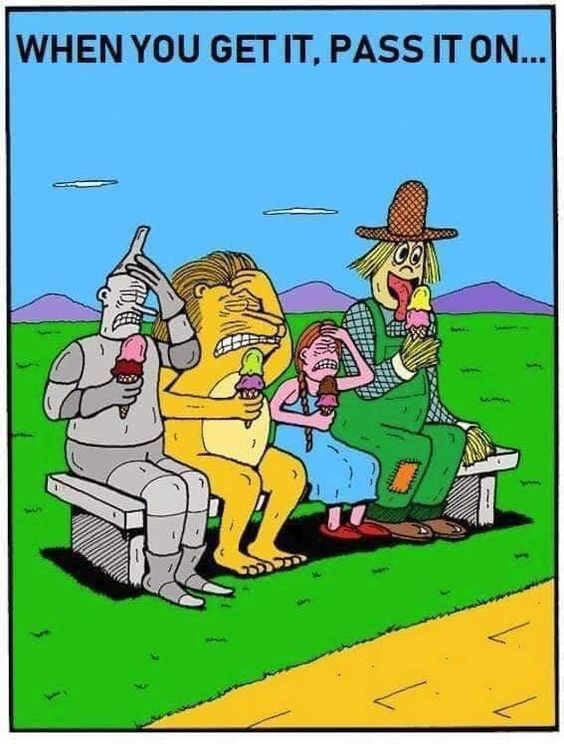
In this Rubes cartoon, there is a visual pun playing out on a park bench. Four characters are seated next to each other: a knight in armor, a yellow animated figure, a crying child, and a scarecrow. They all are holding ice cream cones, but the joke is in the subtle details that relate to the characters. The knight’s ice cream is melting rapidly, likely due to his metal armor heating up in the sun. The animated figure has brain freeze, evident from its pained expression and hand clutching its head. The child is crying, which could be related to the brain freeze or perhaps the ice cream’s coldness. The scarecrow looks unaffected, casually enjoying the ice cream, which is ironic since scarecrows are inanimate and wouldn’t normally eat or feel temperature. The caption “WHEN YOU GET IT, PASS IT ON…” suggests that understanding the joke is part of the fun. The humor comes from the play on words and the physical reactions of the characters that match their personas, a clever twist typical of Rubes cartoons.
8
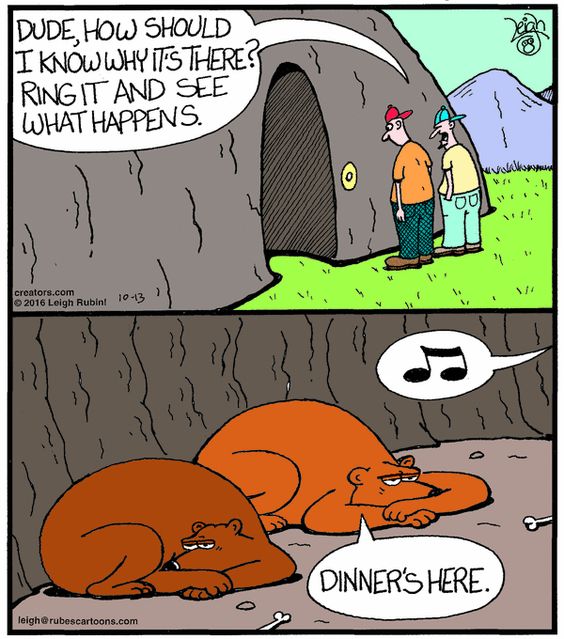
This Rubes cartoon by Leigh Rubin features a humorous scenario split between two panels. In the top panel, two men are standing outside a cave with a doorbell. One man suggests to the other, “Dude, how should I know why it’s there? Ring it and see what happens.” In the bottom panel, inside the cave, we see two large bears, with one commenting, “Dinner’s here,” as a doorbell sound is indicated. The joke here plays on the familiar human action of ringing a doorbell when visiting someone’s home, but with a twist: in this case, the ‘home’ is a cave inhabited by bears who seem to expect the men to be their dinner. The humor is in the unexpected role reversal and the absurdity of a doorbell installed at a cave entrance, which are typical elements of the wit found in Rubes cartoons.
9
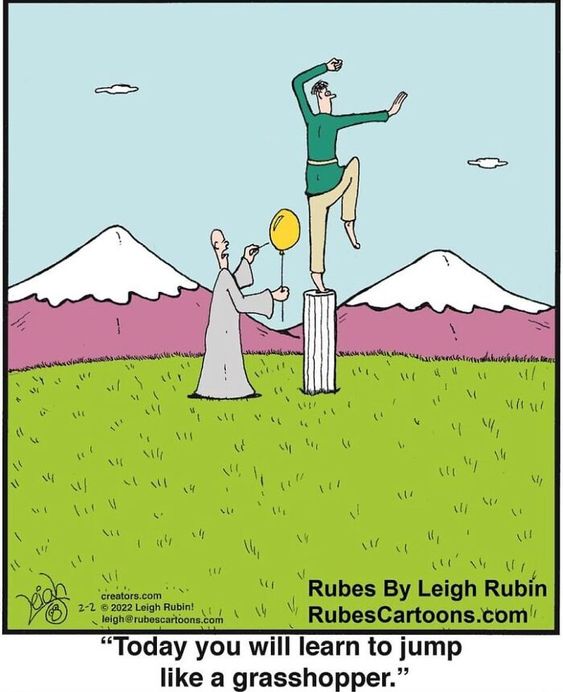
In this Rubes cartoon, we see a comical image where a student is about to learn how to jump high. The scene shows a mentor or teacher, dressed like a monk, holding a balloon and telling the student, “Today you will learn to jump like a grasshopper.” The student is standing on a tall column, positioned as if he is ready to jump high to reach the balloon. This cartoon humorously exaggerates the idea of a training exercise, making it look like a lesson in achieving the remarkable jumping ability of a grasshopper, known for their powerful leaps. The setting is peaceful with mountains in the background, adding to the feeling of a serene training environment, often depicted in stories of martial arts or ancient wisdom teachings.
10
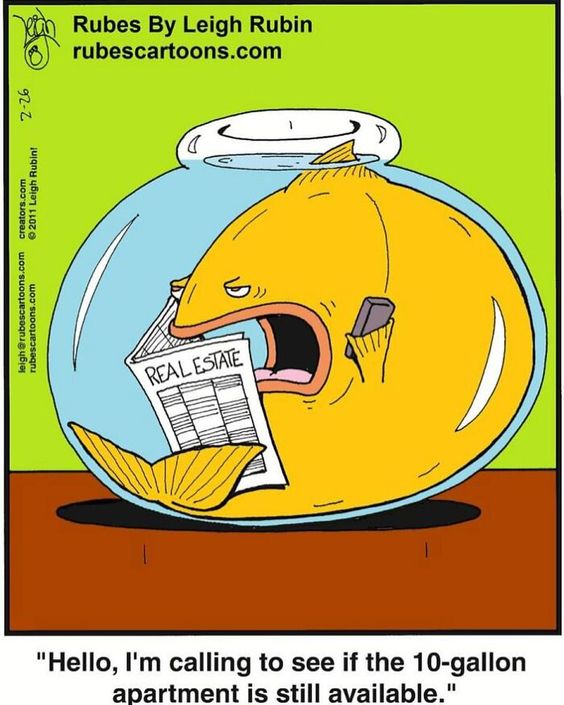
This Rubes cartoon features a fish inside a fishbowl, holding a real estate section of the newspaper and speaking into a phone. The fish says, “Hello, I’m calling to see if the 10-gallon apartment is still available.” The humor here is based on a play on words, combining the concept of apartment hunting with the idea of a fish looking for a new fishbowl, referred to as a “10-gallon apartment.” It’s a creative and funny way to humanize the fish, giving it human desires and problems, like searching for a new place to live, which is typical of the wit and whimsy in Rubes cartoons.
Conclusion
In conclusion, Rubes cartoons stand out as a beacon of joy and creativity in the world of comic art. Leigh Rubin’s ability to blend humor with artistic expression has given life to a cartoon series that resonates with a diverse audience. The universal appeal of Rubes, combined with its unique thematic variety and artistic style, ensures that it continues to be an enduring favorite. As we celebrate the legacy and ongoing journey of Rubes cartoons, it’s clear that they will continue to amuse, inspire, and engage audiences for years to come. With each panel, Rubin invites us into his imaginative world, proving that laughter truly is a universal language.
You Can Also Read More Comics on our website Just click the given Link below:-
Get Ready To Laugh With These 20 New The Far Side Comic Strips

